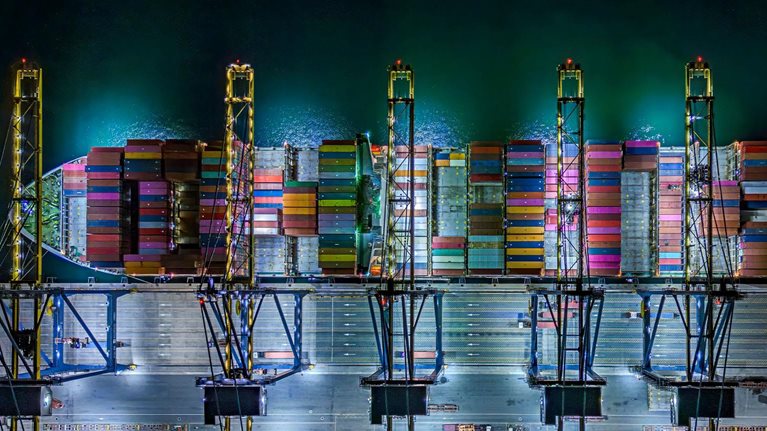Founded in 2013, Flexport is a global supply chain technology platform and logistics provider. Flexport describes its technology platform as providing services “from factory floors to customer doors,” helping cargo owners manage and monitor end-to-end shipments via sea, air, rail, and road, with customs brokerage, direct-to-consumer fulfillment, wholesale distribution, and other services. In 2023, a year in which Flexport’s technology and services were used to move more than $32 billion of merchandise across 112 countries, a $935 million funding round led in part by Andreessen Horowitz raised its valuation to $8 billion.
McKinsey spoke with Flexport founder and CEO Ryan Petersen about ongoing disruptions to supply chain infrastructure, such as the slowdowns at the Panama and Suez Canals. The discussion touches on the knock-on effects of these supply chain disruptions, the role technology can play in mitigating them, and the increasing visibility of logistics across a variety of corporate divisions. The following is an edited transcript of their conversation.
McKinsey: When these supply chain disruptions happen, which industries are most affected?
Ryan Petersen: The industries I’m seeing most affected are those that move components over a long distance in a manufacturing process—especially a process that’s designed to be “just in time.” You saw this with auto manufacturers in Europe having to shut down their lines because they couldn’t get components in fast enough. That’s probably always going to be the most affected category.
The other one is low-margin stuff in general. Furniture is a good example. When you need to move a large amount of volume and the margins aren’t that high, a sudden spike in shipping prices can lead to a real change in the business model and a need to pass through prices to consumers.
You do start to figure out which companies have pricing power. If their costs go way up, can they pass those through or not? It’s a fundamental question for any business. If their markets are just too competitive for them to pass costs through, then they’re going to be really disrupted by any big changes to their supply chains.
McKinsey: How are digital solutions helping to differentiate the performance of customers during these disruptions?
Ryan Petersen: When you talk about what digital can do when responding to disruptions, the first thing to understand is that you can get much more real-time data about what’s happening. If you don’t know what’s happening in real time—and you can’t flow that data seamlessly across partners and geographies and so forth—it’s very difficult to take effective action.
A supply chain involves many companies—it’s a “chain.” And it’s hard for data to flow through these disparate systems. It needs to move between carriers, freight forwarders, customers, and warehouses. Sometimes data management systems are local, on-premises systems that don’t run in the cloud. It’s hard to get data from those systems to tell you, in real time, when a container has been loaded and what’s in it. And then make sure that, when there’s a disruption, you know exactly which products—down to the line item—are going to be delayed or have higher costs.
People who are receiving cargo need to know the updated ETA when there’s a disruption. Maybe they’ll need to get a warehouse ready at a different time, or schedule a truck to come at a different time. It goes downstream, all the way into marketing campaigns—you don’t want to do a huge new product launch if the products are stuck on the ocean.
And this is an area where you need an internet architecture. Getting the data is only half the battle. It needs to be in the hands of all the proper team members with the right permissions and governance models. You need to put data in the hands of frontline decision makers in real time, and not just have it live on some executive dashboard that’s fun to look at but not particularly valuable.
McKinsey: If a customer calls you during one of these crises at 1:00 in the morning, worried and seeking guidance, is there a “playbook”? And if so, what is it? Or, would your answer be, “There is no playbook; you have to treat this like a brand-new crisis every time it happens.”
Ryan Petersen: I think there’s a playbook that should be repeatable across crises. But a lot of this playbook is just: How should we be running modern companies? How do we connect people across the world and build a culture where information flows smoothly and freely to the people who need it?
This is not a static world. We’re constantly trying to understand what’s happening, what we need to know, and whether we need to change our focus. The more you get to be good at that, the more you can build a culture that welcomes disruption. If you’re better at responding to disruption than any other competitor, then disruption can be a net good for your company.
McKinsey: Some manufacturing locations are shifting because of international trade influences or geopolitical disruptions. Traditionally, the people involved in making a decision like that were in manufacturing and sourcing. They didn’t care how the goods moved, and they might have taken the logistics aspects for granted. But are companies now starting to factor in logistics insights and seeking expertise about how goods are going to move? Do you see companies starting to say, “If I move my manufacturing here, what is the actual shipping route? Am I going to be exposed to the Panama Canal? Am I going to be exposed to the Red Sea?”
Ryan Petersen: When we look at the roles of the users on our platform, there are three major groups. The transportation team is responsible for making sure cargo moves where it needs to move to serve operations. The procurement team will make sure the rates are sharp. And then the finance team needs to pay those bills. And often those three teams have slightly different or, in some cases, very different goals.
For example, imagine a large company with a high-gross-margin product and big procurement scale. Its procurement team will just hammer on using that scale to secure cheaper freight rates. But if the product is really high gross margin, the focus should be less on freight rates and more on transit time and reliability—making sure there’s never a situation where that product is not in stock, and therefore the company loses those high-gross-margin sales. Meanwhile, the operations team cares a lot about that transit time for their day-to-day workflow. And the finance team cares about the working capital involved—it might like the cheaper freight rates, but it doesn’t want cargo to sit on the water for a month and a half while paying higher interest rates.
We’ve noticed that finance people are paying a lot more attention to logistics now, especially as they’re able to get more granular data. As interest rates go up, longer transit times mean higher inventory costs and holding costs. People in finance roles also care a lot about payment terms, and payments are triggered either when the goods are picked up or delivered, so they’re going to care about those logistics details. We also increasingly see marketing and sales teams on our platform, and customer service teams—they want to be able to tell their customers when things are arriving.
The more that all these folks are at the table, experiencing real-time data about what’s happening to their products, the more they’re going to want to have a say in making sure that logistics is set up in a way that serves their corner of the organization. Hopefully, that leads to breaking down silos. I think technology has the potential to bring all these teams together. If they can all align to the company’s higher purpose, the tech can pave a way toward better discussions.
McKinsey: If you could wave a magic wand and change one thing about the industry, what would it be?
Ryan Petersen: To me, one of the biggest problems in the industry is people looking at their own businesses in isolation from the broader ecosystem of customers and vendors that they operate within. This creates a lot of mercenary behavior that’s actually self-defeating.
The best example I can point to is that the cancellation rate of bookings placed with ocean carriers approaches 30 percent, on average, across the industry. And those cancellations are treated by the company canceling as “costless,” like, “not my problem.” But obviously, this bears a huge cost for the ocean carrier. It results in them needing to overbook their ships. And then if you’re a shipper worried about getting your cargo bumped off a ship because it’s overbooked, you place two bookings and you cancel one. So it creates these vicious cycles. Now, how does that manifest during a disruption? Everything becomes much more brittle and less responsive to change when there’s constant overbooking and underdelivering.
One path out is for companies to consider the costs of what they’re doing to their vendors or customers and realize that, one way or another, those costs will be passed back through to them. It’s shortsighted to think they won’t. And if we can build a system that uses data to predict that kind of impact, companies might start to be much better partners for their carriers, and in turn, get rewarded for it. In our case, our cancellation rates are less than half of what you see in the rest of the industry. That’s partly because, philosophically, we don’t treat cancellations as “costless,” even though we might not be charged directly for them. But it’s also because we use data and data science to predict our actual booking needs.
There’s inherent variability. You can’t get cancellation rates to zero. And because manufacturing processes are a bit chaotic, you can never get to 100 percent assurance that cargo will be ready on the date that it was supposed to be ready. But you can look at patterns, and you can study the data, and you can have predictive, machine learning models. And that can make you a much better partner for your carrier. And then when capacity is tight, and there is a disruption, and they don’t have enough space, who will they give space to? Are they going to give it to the customer who cancels 30 percent of the time or the one who cancels closer to 10 percent of the time?


